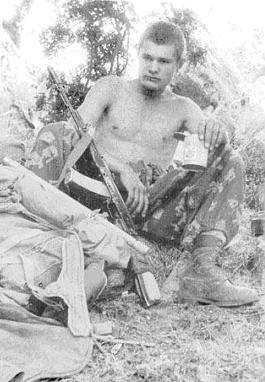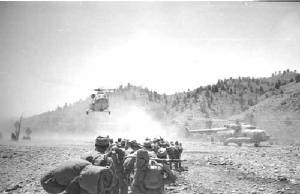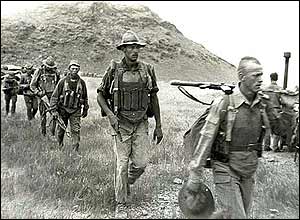|
After the Great Patriotic War, Soviet forces continued to be on a meal plan that
included organized field kitchens when on campaign or in training, group feeding rations (consisting of mostly tinned goods
and dry foods for preparation by squads of soldiers) and generalized “mobile” individual rations when on campaigns.
These individual rations were, in many cases anything but. Large cans of soups, spreads
and fish/meat conserves were issued, which normally could not be logically divided. This was somewhat OK under the primary
Warsaw Pact doctrine of using massed mechanized forces, where at least the crews of vehicles could conduct joint cooking,
but caused grief in all situation where troops were either operating dismounted from their vehicles, or had to operate away
from re-supply for several days at a time.
Troops specializing in dismounted ops were issued with a stunning array of canned,
dehydrated and condensed foods, but never with any consistency. From intelligence evaluations of kit carried by Soviet Bloc
“Advisors” in Southern Africa, for example, it is obvious that the higher on the “special Ops” food
chain troops were, the more suitable to their mission their ration packs would become.
While basic enlistees in mechanized forces or ground support roles were found to
carry locally baked bread, bottled drinks and some form of canned meat, special units such as Spetsnaz had actual purpose-built
rations.
In the early 1980’s such specialist rations included:
-The canned bread/biscuit ration from the East German “E-
Päckchen” (Click the title to go to the picture page)
-Canned Meats/Fish ranging from corned beef to more
traditional
Russian dishes
-Malted Milk Tablets
-Vitamin Tablets/Chewable fruit candy
-Tubes of Condensed Milk (These were, in many cases, purchased from various sources,
including Holland, Belgium or West Germany—All three NATO countries!!!)
-Iodine-based water purification tablets (in tiny brown bottles with a white label)
-Emergency ration bars (both Russian and East German
versions
were used)
Naval Spetsnaz units were issued with portions of the naval/submarine emergency ration,
which consisted of a plastic-wrapped set of 6 ration bars.

These rations, however, were never standard issues, but rather an eclectic mix put
together on the request and/or advice of officers in such units.
In the mid-late 70s, the so-called “Preserved” individual ration came
into use, which consisted of preserved bread product and canned goods. This ration came in three varieties, none of which
provided even near the caloric supply soldiers in action or on the march needed:
Menu
“A”
One can of preserved meat, generally Tushonka-
Beef, Pork or even Horse with
up to 50% fat.
One pack (100 grams/3.5
oz) of crackers
One can of cheese (3.5
oz)
One tea bag
One cube or bag of sugar
Menu
“B”
Two cans of Kasha with
meat (buckwheat or oat cereal gruel)
One pack (100 grams/3.5 oz) of crackers or preserved (plastic sealed)
bread
Menu
“C”
A can of meat stew (Well,
grease/gristle, vegetable, potato mix…)
One can of Vegetables/Starch (could be a rice dish, potatoes, Beets) or a
can of Fruit One pack (100 grams/3.5 oz) of crackers

OVER THE MOUNTAINS
When the Soviet Union invaded Afghanistan in 1979 not only to broaden its influence
in Asia, but also to stop Muslim extremists from entering Soviet Republics rife with religious fanatics, it’s troops
were unprepared for the type of warfare they would encounter.
In the terrain where most of the battles against the Mujahideen were fought, standard
Soviet-Bloc tactics could not succeed. The elusive enemy could neither could be engaged by superior artillery or air attacks,
nor could the forte of the “Soviet Steam-Roller”, the armored force, be brought to bear, as most terrain was unsuitable
to vehicle traffic, leave alone armored maneuvering.
This left a vast number of infantry actions, mostly without direct support by either
weapons carrying aircraft or vehicles, or even supply vehicles, a mode of support the Soviet doctrine had been designed to
function around.
In no time at all, the shortcomings of the existing Preserved Ration became apparent.
First, the lack of variety and nutritional value hampered operations by soldiers not only under-nourished, but also woefully
unprepared for vigorous activity not only in weather extremes, but also at dizzying altitudes. Secondly, the lack of any sort
of supplemental rations failed to take into account the need for troops to add additional calories and nutrients when on patrol,
based on climate and mission specifications.
In 1980, the nutritional shortcomings of standard and preserved rations came to the
notice of the Soviet state equipment and procurement ministries, when health problems in troops arose. One type of health
problems relating to mal-nutrition developed in troops solely subsisting on Preserved rations, which included lack of performance,
debilitating cases of scurvy, dental problems and proneness to secondary illness. The
second, vastly more disturbing type of health problem was noticed in troops on garrison and rear-echelon duties. Outbreaks
of food poisoning, disabling bouts of influenza, and wave after wave of e-coli based illnesses brought entire sectors to less-than-minimum
readiness standards. Quickly dispatched health researchers and veterinary specialists (backed by a goodly amount of Military
Police and KGB “observers”) initially suspected a concerted biological weapon or sabotage attack by insurgents,
but soon discovered the real culprit.
While the isolated units relying on short prepared rations mostly suffered from conditions
additional (and more nutritionally sound) rations could mitigate, the vast majority of food problems was caused by the Soviet
system of food preparation and distribution in general. Cooks could not be held to even basic sanitary standards in many of
the garrisons that were short of clean water. Power to refrigeration units could barely be kept up. Fresh food supplies were
either already spoiled when procured by the military, or were likely to spoil before reaching their destination. Local climate
changes caused foods that ordinarily would be safe to spoil even when prepared under sanitary conditions.
And, last but not least, troop supply from field kitchens caused previously safe
to eat foods that were already prepared to spoil on the way to the soldiers, either from delays in transport, lack of cleanliness
in transport containers, or lack of cleanliness in the individual mess containers used.
|

